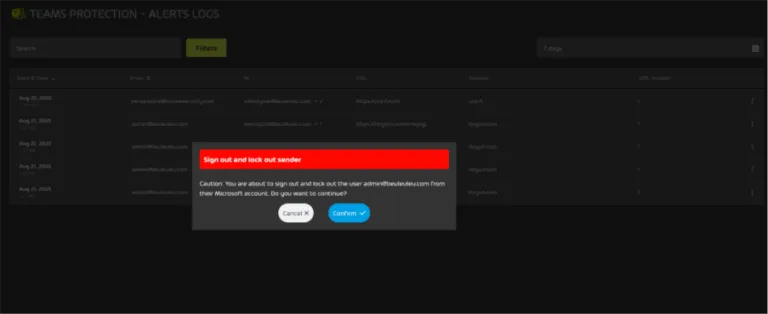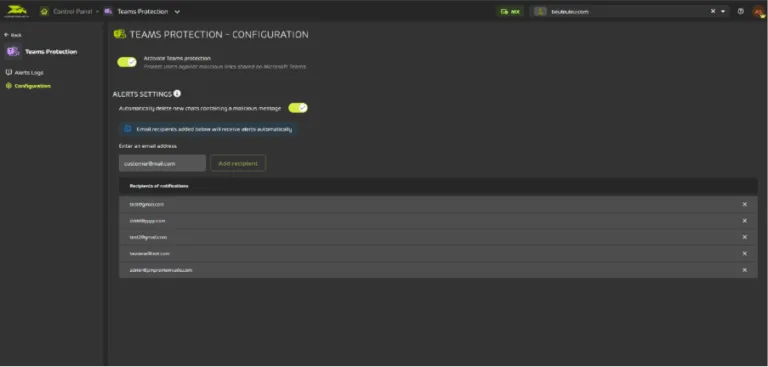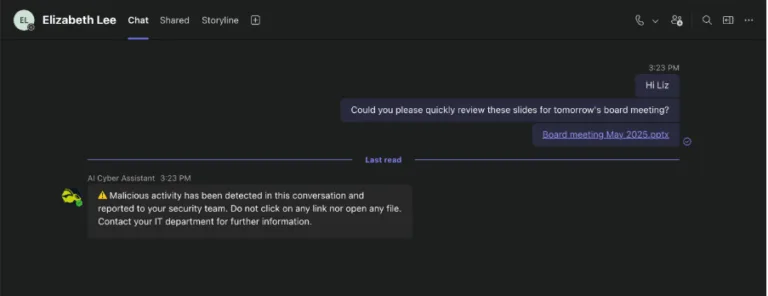

Microsoft Teams Exploits: The New Playground for Cybercriminals
Microsoft Teams exploits are on the rise, making chat-based phishing one of the biggest cybersecurity challenges for organizations today. If we cast our minds back to similar times: it’s a Friday night, you boot up your Gateway computer and open MSN messenger.
You have a new chat message from someone who’s not in your contact list “sup, ASL?”. Back then, it seemed harmless to accept messages from people you didn’t know. These days, the phrase “Got a sec for a quick chat?” could cost you more than the embarrassment of oversharing.
Microsoft Teams has become the new phishing frontier, in the first half of 2025 identity-based attacks rose by 32%, which is why Microsoft Teams is now a major attack vector alongside email.
Attackers are increasingly targeting credentials and non-human identities like AI bots and apps. A compromised account or app can bypass many security controls by acting like a “trusted” user or bot.
Microsoft Teams is a high value collaboration platform that once compromised, allows attackers to move laterally within the organization, exfiltrate data and build information for further targeted spear phishing or whaling campaigns.
This article will unpack how identity-based attacks (now making up 30% of cyber intrusions) are thriving inside Teams and why traditional email defenses aren’t enough.
We will explore how Hornetsecurity’s Teams Protection, powered by AI Cyber Assistant, detects and neutralizes threats in real time – scanning every URL, analyzing over 47 link characteristics, and even reading images for phishing cues.
The Human Factor Behind Microsoft Teams Phishing
Now that our lives are so connected, we tend to be busier than ever. How often do we get a quick message from a colleague during a Teams meeting with a “Hey you got a sec?”. It seems innocent, but it’s this type of human driven conversation that lures us into becoming the next victim of this Microsoft Teams exploit.
This method of phishing and social engineering isn’t just isolated to email. Bad actors are increasingly becoming more targeted and human-like in their approach. The fast-paced nature of collaboration tools is exactly what attackers exploit.
The Fast-Paced World of Teams and Its Hidden Dangers
The most common Microsoft Teams exploits include phishing links, compromised accounts and application abuse. IBM’s Threat Intelligence Index highlights how the landscape is changing. The global average cost of a data breach reached an unprecedented $4.88 million in 2024.
The extent of the damage caused by these types of attacks has been publicly demonstrated within the real world.
Several examples in recent times show how severe Microsoft Teams exploits can be:
Midnight Blizzard
Midnight Blizzard, also known as APT29, Nobelium, or Cozy Bear, is a Russian linked black hat group. They are known for espionage campaigns against governments and technology companies. Microsoft reported the group uses Microsoft Teams exploits for social engineering. They pose as technical support staff to bypass Multifactor Authentication prompts.
The group leveraged compromised Microsoft 365 tenants from small businesses to pass off as legitimate. They persuade targets to steal session tokens effectively. Approximately 40 organizations were affected by this type of attack. This highlights how trusted collaboration tools like Microsoft Teams are weaponized.
BlackBasta
BlackBasta is a prolific ransomware operation that has evolved traditional phishing into highly targeted social engineering campaigns. The most recent activity by the group is the use of Microsoft Teams exploits to impersonate internal IT help desk over the platform to gain remote access.
BleepingComputer reported that once they had access to the systems, they would deploy malicious software and spread this throughout the network, this has become an effective way to bypass defenses such as email security to target organizations through the human layer.
In both examples, compromised accounts threaten not only internal teams but also customers. CISA and Microsoft have both warned about rising Teams based social engineering. An internal account breach is far more dangerous than an external one. So, what can organizations do to protect themselves?
Why Traditional Security Doesn’t Cover Teams
Microsoft offers many tools to help protect against external forces attacking your environment. Traditional tools like Defender for Office 365 protects email, performs spam filtering and even attachment sandboxing, but it doesn’t protect against these Microsoft Teams security vulnerabilities. We can lock down our environment to help reduce the possibility of external people making contact with your staff. See this blog post about how to lock down external contacts.
All these controls aren’t going to protect you once an account is compromised, so how can you react in a timely manner if you don’t have a method to inspect the content of messages inside collaboration tools like Microsoft Teams? The question we need to ask is “Is Microsoft Teams Secure enough on its own?”.
Key findings on account compromise
According to Hornetsecurity’s 2025 Cyber Security Report, compromised accounts remain one of the leading causes of internal data exposure in Microsoft 365 environments.
This highlights why internal communication channels like Microsoft Teams require dedicated protection beyond traditional perimeter or email security tools.
How Hornetsecurity’s Teams Protection Closes the Gap
With the rise of the new cyber threat and the changes to the defense landscape, this is where Hornetsecurity’s AI Cyber Assistant steps in, specifically the Teams Protection module that directly integrates into the 365 Total Protection Plan 4.
This tool has been designed to assist organizations who leverage Microsoft 365 for collaboration and close this gap by utilizing AI powered security features with deep automation. Microsoft Teams Protection is the solution to this issue.
Scans all Teams messages for malicious URLs or files
Teams Protection is powered by the same AI technology as Hornetsecurity’s Secure Links. Smart patterns analyze key features of URLs and pages (e.g. redirections, file paths, scripts, etc.) to identify malicious content and bad actors if your Microsoft Teams is compromised. It can detect known suspicious links and threats, even with newly created or rapidly changing domains.
Uses AI Cyber Assistant to warn users in real time
The AI Cyber Assistant is a machine learning defender in Microsoft Teams Chats. It is always on and built on Hornetsecurity’s established email protection AI models. Every Microsoft Teams message is scanned in real time for malicious links.
The machine learning engine evaluates link behavior, sender reputation and message patterns to spot zero-day AI generated phishing that traditional filters might miss. The protection learns and adjusts at lightning speeds to ensure immediate protection to your staff.
Detects hidden threats through machine learning and deep learning (47+ link characteristics, image-based analysis)
Supervised and unsupervised machine learning algorithms analyze over 47 characteristics of URLs and web pages. They scan for malicious behaviors, obfuscation techniques, and URL redirects. Computer Vision models analyze images to extract relevant features used in phishing attacks. This includes brand logos, QR codes, and suspicious textual content embedded within images.
Enables admins to delete malicious chats and lock compromised users instantly
Administrators can immediately remove detected Microsoft Teams messages or even entire chat threads. If the system does determine an account has been compromised, it can automatically lock the user session or account to prevent any further lateral movement.

Offers auto-remediation for newly created malicious conversations
If a threat actor tries to start a new conversation after an account has been compromised, Teams protection detects and deletes it automatically, preventing the spread before users even get the chance to interact with it. Auto-remediation and real-time alerts keeps IT’s response quick and efficient.

The AI Cyber Assistant – Your Always-On Defense Partner
Hornetsecurity’s AI Cyber Assistant is your digital security teammate that provides oversight across communications in real time. Let’s take a look at some of the key features that set this product apart from the rest.
Warns users directly in chat
AI Cyber Assistant will monitor all chats, attachments, links, and when it detects suspicious activity, it warns the user immediately within the chat. This drastically reduces the attack layer of an organization and plugs the security gap that internal compromised accounts pose.

Continuously learns from evolving threats
The core to the AI Cyber Assistant is the engine room that is Hornetsecurity’s global threat intelligence network. This processes millions of emails, messages and links daily meaning the speed at which it can learn emerging threats is second to none.
Instead of your standard static systems, the AI Cyber Assistant will study patterns in message tone, the construction of links, the behavior of senders and the context in which the delivery was made. All of these components keep the system agile against AI generated and polymorphic attacks.
Reduces IT workload through automation
The AI Cyber Assistant significantly reduces the load on IT and SOC teams by automating many time-consuming tasks across Microsoft 365. Its ability to automatically analyze, learn, react, warn and respond to events removes a large majority of manual triage tasks by IT teams. The combination of real time alerting for users not only protects but educates the organization.
Consolidation of detection, alerting and remediation into the one platform streamlines operations and addresses the ‘single pane of glass’ requirement.
Integrates seamlessly with the 365 Total Protection Plan 4
The 365 Total Protection Plan 4 is the pinnacle of security within your Microsoft 365 tenant. The AI Cyber Assistant integrates seamlessly into the plan operating as a native extension of Microsoft 365 rather than just an add-on product.
Because 365 Total Protection Plan 4 is built specifically for the Microsoft 365 ecosystem, deployment is quick with no additional connectors or complex infrastructure.
Smarter, Safer Collaboration for the Modern Workplace
Modern work relies on seamless collaboration with internal and external parties. But as Microsoft Teams becomes the heart of communication, it also becomes a growing target for sophisticated attacks.
As we’ve seen, Hornetsecurity’s 365 Total Protection Plan 4, powered by AI Cyber Assistant and Teams Protection, allows organizations to remain agile and productive without compromising security.
By learning continuously from the global threat intelligence safeguarding, analyzing every chat, link and file, protection is in real time preventing emerging attacks before they spread. All of these capabilities align with the broader Hornetsecurity 365 ecosystem which protects email, Teams, endpoints, and identity, all part of a unified Microsoft 365 defense platform.
The result: a smarter and safer collaboration environment where your staff can work confidently and your IT teams can sleep easy at night.
Don’t Let Hackers Join Your Teams Conversation
Your Teams chats move fast, don’t let threats move faster. With Hornetsecurity’s Teams Protection, you can:
- Detect and neutralize malicious links in real time.
- Automatically warn users of dangerous content.
- Stop compromised accounts from spreading attacks.
- Simplify remediation with AI-driven automation.

Safeguard your collaboration space and your people effortlessly. Give your users confidence and your IT team peace of mind, all without adding complexity. Schedule your free demo today and experience next-generation protection for Microsoft Teams.

Conclusion
Microsoft Teams is the foundation of modern work collaboration, allowing teams to communicate fast and efficiently. With this agility, Microsoft Teams becomes the prime target for attackers to exploit the trust of internal communication.
Hornetsecurity’s AI-Powered Teams Protection, part of the 365 Total Protection Plan 4, closes this gap by securing every message, file and link without impacting the end user experience. It’s the quiet achiever working tirelessly in the background to warn users, remediating malicious activity and keep your organization safe, seamless, and productive.
Just like MSN messenger we want to protect our teams from those unwanted nudges and rogue contacts. As Microsoft Teams continues to evolve, Hornetsecurity remains at the forefront of AI-driven collaboration security, safeguarding over 125,000 companies worldwide.
FAQ
Traditional email security focuses primarily on email threats, leaving collaboration tools like Teams vulnerable. Microsoft Teams requires dedicated protection to guard against internal breaches and specific exploits that email defenses may overlook.
Yes, it can immediately delete malicious chats and lock compromised accounts to prevent any further spread of threats. This automatic response enables organizations to react swiftly, minimizing potential damage.
Hornetsecurity’s Teams Protection defends against various threats such as phishing links, compromised accounts, and malicious applications. It uses AI to analyze messages and detect suspicious content in real time, ensuring your Teams communications remain secure.

